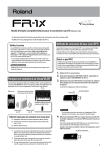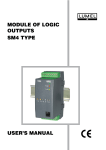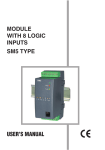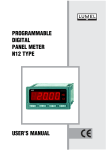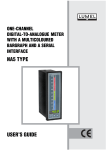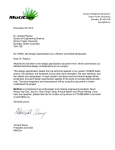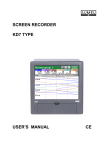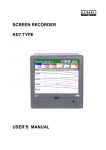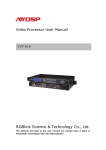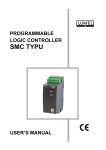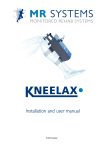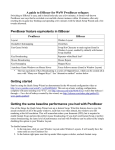Download 2-channel module of analog inputs sm1 type user`s manual
Transcript
2-CHANNEL MODULE OF ANALOG INPUTS SM1 TYPE USER’S MANUAL 1 2 CONTENTS 1. APPLICATION ..............................................................................................5 2. MODULE SET ..............................................................................................6 3. BASIC REQUIREMENTS AND OPERATIONAL SAFETY ..........................6 4. INSTALLATION ............................................................................................8 4.1. Way of fixing ..........................................................................................8 4.2. Diagrams of external connections .........................................................9 5. HANDLING .................................................................................................12 5.1. Description of the MODBUS protocol implementation ........................12 5.2. Description of the MODBUS protocol function ....................................13 5.3. Map of registers ...................................................................................16 5.4. Registers only for readout ...................................................................17 5.5. Registers for write and readout ...........................................................21 6. TECHNICAL DATA.....................................................................................29 7. BEFORE A DAMAGE WILL BE DECLARED ............................................31 8. EXAMPLES OF THE SM1 MODULE PROGRAMMING............................32 9. ORDERING CODES...................................................................................34 10. MAINTENANCE AND WARRANTY ...........................................................35 3 4 1. APPLICATION The SM1 2-channel module of analog inputs is destined to convert standard signals, resistance or temperature signals into numerical data accessible via the RS-485 or RS-232 port by means of the MODBUS protocol. The measurement is carried out independently in two channels. RS-485 and RS-232 output ports are galvanically insulated from input signals and the supply. The module programming is possible by means of the RS-485 or RS-232 port. In the set of SM1 module there is a connecting cable, to connect with the PC computer (RS-232). The SM1 module realises following functions: mathematical operations on channels and between measuring channels, conversion of measured or calculated quantities basing on the individual linear characteristic, storage of maximal and minimal values for both channels, programming of the measurement averaging time, servicing of RS-485 and RS-232 interfaces in MODBUS protocol, both in ASCII and RTU mode. Fig. 1. View of the SM1 module 5 2. SET OF THE SM2 MODULE The set consists of: - SM1 module .......................................................................... 1 pc. - user’s manual ........................................................................ 1 pc. - warranty card......................................................................... 1 pc. - plug with screw terminals ...................................................... 2 pcs - hole plug of the RS-485 and RS-232 sockets ....................... 1 pc - RS-232 cable to connect to the computer (1.5 m.)................ 1 pc When unpacking the module, please check whether the type and execution code on the data plate correspond to the order. 3. BASIC REQUIREMENTS, SAFETY INFORMATION Symbols located in this service manual mean: WARNING! Warning of potential, hazardous situations. Especially important. One must acquaint with this before connecting the module. The non-observance of notices marked by these symbols can occasion severe injuries of the personnel and the damage of the module. CAUTION! Designates a general useful note. If you observe it, handling of the module is made easier. One must take note of this, when the module is working inconsistently to the expectations. Possible consequences if disregarded! In the security scope the module meets the requirements of the EN 61010 -1 standard. Remarks concerning the operator safety: 1. General The SM1 module is destined to be installed in measuring systems. Non-authorized removal of the required housing, inappropriate use, incorrect installation or operation create the risk of injury to personnel or damage to equipment. For more detailed information please study the user’s manual. 6 All operations concerning transport, installation, and commissioning as well as maintenance must be carried out by qualified, skilled personnel and national regulations for the prevention of accidents must be observed. According to this basic safety information, qualified, skilled personnel are persons who are familiar with the installation, assembly, commissioning, and operation of the product and who have qualifications necessary for their occupation. 2. Transport, storage Please observe the notes on transport, storage and appropriate handling. Observe the climatic conditions given in Technical Data. 3. Installation The module must be installed according to the regulation and instructions given in this user’s manual. Ensure proper handling and avoid mechanical stress. Do not bend any components and do not change any insulation distances. Do not touch any electronic components and contacts. Modules may contain electrostatically sensitive components, which can easily be damaged by inappropriate handling. Do not damage or destroy any electrical components since this might endanger your health! 4. Electrical connection Before switching the module on, one must check the correctness of connection to the network. In case of the protection terminal connection with a separate lead one must remember to connect it before the connection of the module to the mains. When working on live modules, the applicable national regulations for the prevention of accidents must be observed. The electrical installation must be carried out according to the appropriate regulations (cable cross-sections, fuses, PE connection). Additional information can be obtained from the user’s manual. Apply a two-wire cable for the connection to the network acc. to the EN 61010-1 standard. Do not connect the module to the network through an autotransformer. In the building installation, a cut-out or a circuit-breaker should exist, situated near the device and easy accessible to the operator. It should be marked as the element switching the device out. 7 The documentation contains information about installation in compliance with EMC (shielding, grounding, filters and cables). These notes must be observed for all CE-marked products. The manufacturer of the measuring system or installed devices is responsible for the compliance with the required limit values demanded by the EMC legislation. 5. Operation Measuring systems including SM1 modules must be equipped with protection devices according to the corresponding standard and regulations for prevention of accidents. After the instrument has been disconnected from the supply voltage, live components and power connections must not be touched immediately because capacitors can be charged. The housing must be closed during operation. The RS-232 socket serves only to connect the device (Fig.5) working with the MODBUS protocol. When the module is not used place the hole plug in the RS-232 socket of the module. 6. Maintenance and servicing. Please observe the manufacturer’s documentation. Read all product-specific safety and application notes in this user’s manual. Before taking the module out, one must turn the supply off. The removal of the module housing during the warranty contract period may cause its cancellation. 4. INSTALLATION 4.1 Way of fixing The SM1 module is fixed on a 35 mm rail in accordance with EN 60715. The module housing is made of a self-extinguishing plastic. Overall dimensions of the housing: 22.5 120 100 mm. One must connect to the module, external wires with cross-section up to 2.5 mm2 (from the supply side) and 1.5 mm2 (from the input signal side). Overall dimensions and the fixing way are presented on the fig. 2. 8 Fig.2. Overall dimensions and way of fixing the module 4.2. External connection diagrams Make the connection of input signals, supply and interface acc. to the fig. 3, 4 and 5 Fig.3 Connection way of external signals. The connection diagram is also placed on the module housing 9 The polarization is optional when supplying by c.d. voltage. Measured signal 2 voltage inputs Connection way 2 current inputs Measured signal 2 Pt100 inputs or resistance measurement up to 400 : Connection way 1 voltage input + 1 current input Fig. 4 Connection way of input signals Taking in consideration electromagnetic interference one must use shielded wires to connect input signals and output signals. The supply must be connected by a two-wire cable, with the appropriate wire diameter ensuring its protection by means of a safety fuse. 10 Fig. 5 Connection way of RS-485 and RS-232 interfaces 11 5. HANDLING After connecting external signals and switching the supply on, the SM1 module is ready to work. The lighted green diode signals the module work. The green (RxD) diode signals the module polling, however the yellow diode (TxD) signals the module response. Diodes should ignite in cycles during the data transmission, both through the RS-232 and the RS-485 interface. One can program all module parameters by means of RS-232 or RS-485. The RS-232 port has constant transmission parameters in accordance with technical data, what enables the connection with the module even when programmed parameters of the RS-485 digital output are unknown (address, mode, rate). The RS-485 standard allows to the direct connection to 32 devices on a single serial link up to 1200 m. To connect a greater number of devices, it is necessary to use additional intermediate-separating systems. The way of the interface connection is given in the user’s manual (fig.5). To obtain the correct transmission, it is necessary to connect A and B lines in parallel with their counterparts in other devices. The connection must be carried out with a screened wire. The screen must be connect to the protective terminal in a single point. The GND line serves to the additional protection of the interface line at long connections. One must connect it to the protective terminal (it is not necessary for the correct interface work). To obtain the connection with the PC computer through the RS-485 port, an RS-232/RS-485 converter (e.g. PD51 of Lumel’s production) or an RS-485 interface card is indispensable. The marking of transmission lines for the card in the PC computer depends on the card manufacturer. To obtain the connection through the RS-232 port, the wire added to the module is sufficient. The connection way of both ports (RS-232 and RS-485) is shown on the fig. 5. The module can be connected to the device of master type only through one interface port. In case of a simultaneous connection of both ports, the module will work through the RS-232 interface. 5.1. Description of MODBUS protocol implementation The transmission protocol describes ways of the information exchange between devices through serial links. The MODBUS protocol has been implemented in the module in accordance with the PI-MBUS-300 Rev G specification of the Modicon company. Set of parameters of the module serial link in the MODBUS protocol: Module address - 1...247 Baud rate - 2400, 4800, 9600, 19200, 38400, 57600, 115200 bit/s Working modes - ASCII, RTU 12 Information unit Maximal response time - ASCII: 8N1, 7E1, 7O1 - RTU: 8N2, 8E1, 8O1, 8N1 - 300 ms. The parameter configuration of the serial link is described in the further part of the user’s manual. It consists on establishing the baud rate (Rate parameter), device address (Adres parameter) and the information unit type (Mode parameter). In case of the module connection with the computer through the RS-232 wire, the module set automatically following transmission parameters: Baud rate: 9600 bps, Working mode: RTU 8N1, Address: 1. Notice: Each module connected to the communication network must: have a unique address, different from addresses of other devices connected to the network, identical baud rate and information unit type, the message sent with the address „0” is identified as the data transmission mode (transmission to many devices). 5.2. Description of the MODBUS protocol function Following functions of the MODBUS protocol have been implemented in the SM1 module Opis funkcji Code Signification 03 (03 h) 06 (06 h) 16 (10 h) 17 (11 h) Readout of n-register Write of a single register Write of n-registers Slave device identification Readout of n-registers (code 03h) The function is not accessible in the broadcast mode. Example: Readout of 2 registers beginning by the register with the 1DBDh address (7613). RTU mode. Demand: Device address Function 01 03 Register address Hi 1D Lo BD Number of registers Hi 00 Lo 02 Checksum CRC 52 43 13 Answer: Device address Number Function of bytes 01 03 08 Value from the register 1DBD (7613) Value from the register 1DBE (7614) 3F 40 80 00 00 00 00 Checksum CRC 42 8B 00 Writing of values in the register (code 06h) The function is accessible in the broadcast mode. Example: Write the register with 1DBDh (7613) address. RTU mode. Demand: Device address Function 01 06 Register address Hi 1D Lo BD Value for the register 1DBD (7613) 3F 80 00 Checksum CRC 85 AD 00 Answer: Device address Function 01 06 Register address Hi 1D Lo BD Value from the register 1DBD (7613) 3F 80 00 Checksum CRC 85 AD 00 Writing in n-registers (code 10h) The function is accessible in broadcast mode. Example: Write of two registers beginning from the register with 1DBDh (7613) address Device address Function Demand: 01 10 Register Number of address registers Number Value for the register Value for the register 1DBD (7613) 1DBE (7614) Hi Lo Hi Lo of bytes 3F 80 00 00 40 00 00 00 1D BD 00 02 08 Answer: Device address Function 01 10 14 Register address Hi 1D Lo BD Number of registers Hi 00 Lo 02 Checksum CRC D7 80 Checksum CRC 03 09 Report identifying the device (code 11h) Demand: Device address 01 Checksum (CRC) Function 11 C0 2C Answer: Device address Function Number of bytes Device identifier Device state Field depending on the device type 01 11 08 88 FF XXXXXX Device address - depends on the set value Function - function number: 0x11 Number of bytes - 0x08 Device identifier - 0x88 Device state - 0xFF Field depended of the device - XXXXXX Output of OC type - 0x00 - not occurs, Type of input Number of the software version Checksum Checksum 00 X X X X X - Field depended on the module execution code: - 0x00 - two 0...10 V voltage inputs, X 00 X X X X - 0x01 - two 0/4...20 mA current input2, X 01 X X X X - 0x02 - one 0...10 V voltage input, one 0/4...20 mA current input2, X 02 X X X X - 0x03 - two Pt100 inputs or two resistance inputs up to 400 :, X 03 X X X X - software version implemented in the module X X_ _ _ _4 - byte variable of float - 2 bytes in case of work in RTU mode - 1 byte in case of work in ASCII mode Example: Work in RTU mode, e.g. Mode = RTU 8N2 (value 0x02 in case of readout/write through the interface The device address is set on Adr=0x01 15 For the SM1 module the answer frame has the following shape: Device address Function Number of bytes Device identifier Device state Field depending on the device type Checksum 01 11 08 88 FF 00 01 3F 80 00 00 03 7D It is the SM1 module: - with two 0/4...20 mA current inputs - software version: 1.00 5.3. Register map Register map of SM1 series modules Address range Value type 7000-7200 float (32 bit) The value is placed in two successive 16-bit registers. Registers contain the same data as 32-bit registers from the area 7500. The register is for readout only 7200-7400 float (32 bit) The value is placed in two successive 16-bit registers. Registers contain the same data as 32-bit registers from the area 7600. Registers can be read out and written. 7500-7600 float (32 bit) The value is placed in the 32-bit register. The register is for readout only. 7600-7700 float (32 bit) The value is placed in the 32-bit register. Registers can be read out and written. 16 Description The value is placed into 32-bite registers. 7000 7500 Name Identifier Write (w)/Readout (r) The value is located in two successive 16-bite registers. These registers include the same data as 32-bite registers from the area 7500. 5.4. Registers only for read-out r Unit - Quantity name Constant identifying the device Value 0x88 - - h 0x - - 00h 0x - - 01h 0x - - 02h SM1 identifier Two 0...10 V voltage inputs Two 0/4...20 mA current inputs One 0...10 V voltage input One 0/4...20 mA current input 0x - - 03h 2 Pt100 inpus or 2 resistance inputs up to 400 : 7002 7501 Status 1 r - 7004 7502 Status 2 r - 7006 7008 7010 7012 7014 7016 7018 7020 7022 7024 7026 7028 7030 7032 7034 7503 7504 7505 7506 7507 7508 7509 7510 7511 7512 7513 7514 7515 7516 7517 W1 W2 W3 W4 WF Min 1 Max 1 Min 2 Max 2 Min 3 Max 3 Min 4 Max 4 WF Min WF Max r r not occurs not occurs r r r r r not occurs not occurs not occurs not occurs r r - Status 1 is the register describing the present module state Status 2 is the register describing the present module state Measured value on the input 1 Measured value on the input 2 Calculated value basing on the function Minimum of the measured value on the input 1 Maximum of the measured value on the input 1 Minimum of the measured value on the input 2 Maximum of the measured value on the input 2 Minimum of the calculated value Maximum of the calculated value 17 Signalling of the upper input 2 range exceeding Individual characteristic of the input 2 Individual characteristic of the input 1 X X X X X X X X X X X X X X X X bits 15 14 13 12 11 10 9 8 7 6 5 4 3 2 1 0 Signalling of the lower input 1 range exceeding Signalling of the upper input 1 range exceeding Signalling of the lower input 2 range exceeding Description of the Status1 register MSB Bit-15...8 Not used Bit value is always equal 0 Bit-7 Signalling of the lower range exceeding of input 2 0 - normal work 1 - range exceeding Bit-6 Signalling of the upper range exceeding of input 2 0 - normal work 1 - range exceeding Bit-5 Signalling of the lower range exceeding of input 1 0 - normal work 1 - range exceeding Bit-4 Signalling of the upper range exceeding of input 1 0 - normal work 1 - range exceeding 18 LSB Bit-3...2 Not used Bit value is always equal 0 Bit-1 Individual characteristic of the input 2 0 - individual characteristic switched off 1 - individual characteristic switched on Bit-0 Individual characteristic of the input 1 0 - individual characteristic switched off 1 - individual characteristic switched on State of input 1 X X X X X X X X X X X X X X X X bits 15 14 13 12 11 10 9 8 7 6 5 4 3 2 1 0 MSB Baud rate Type of inputs State of input 2 Working mode and information unit Description of the Status 2 register LSB Bit-15...11 Not used Bit value is always equal 0 Bit-10 State of measuring input 2 0 - channel switched off (lack of measurement) 1 - channel switched on Bit-9 State of measuring input 1 0 - channel switched off (lack of measurement) 1 - channel switched on 19 Bit-8...6 Working mode and information unit 000 - interface switched off 001 - 8N1 - ASCII 010 - 7E1 - ASCII 011 - 7O1 - ASCII 100 - 8N2 - RTU 101 - 8E1 - RTU 110 - 8O1 - RTU 111 - 8N1 - RTU Bit-5...3 Baud rate 000 - 2400 bit/s 001 - 4800 bit/s 010 - 9600 bit/s 011 - 19200 bit/s 100 - 38400 bit/s 101 - 57600 bit/s 110 - 115200 bit/s Bit-2...0 Type of inputs 000 - 2 x 0...10 V 001 - 2 x 0/4...20 mA 010 - 1 x 0...10 V, 1 x 0/4...20 mA 011 - 2 x Pt100 resistance thermometer inputs or 2 x resistance inputs up to 400 : 20 The value is placed in 32-bit registers. 7200 7600 Symbol Identifier Write (w)/Readout (r) The value is placed in two successive 16-bytes registers. These registers include the same data as 32-bit registers from the area 7600. 5.5. Registers for readout and write r Table 1 Range Description - Device identifier Value 0x88 - - h SM1 Identifier 0x - - 00h Two 0...10 V voltage inputs 0x - - 01h Two 0/4...20 mA current inputs 0x - - 02h One 0...10 V voltage input One 0/4...20 mA current input 0x - - 03h Two Pt100 inputs or two resistance inputs up to 400 : 7202 7601 Rate W/r 0... 3 Baud rate of the RS-485 interface (bit/s) Value 7204 7602 Mode W/r 0... 7 0 2400 1 4800 2 9600 3 19200 4 38400 5 57600 6 115200 Kind of transmission through the RS-485 interface Value 0 1 2 3 4 5 6 7 Interface switched off ASCII 8N1 ASCII 7E1 ASCII 7O1 RTU 8N2 RTU 8E1 RTU 8O1 RTU 8N1 21 7206 7603 Address W/r 0... 247 Device address 7208 7604 Apply W/r 0... 1 Acceptation of module transmission parameter changes Value 0 1 7210 7605 Input 1 W/r 0... 1 Lack of reaction Acceptation of changes Switching ON/OFF of the measuring input 1 Value 0 1 Measuring input switched off Measuring input switched on In case of the input off the value 0 is returned 7212 7606 W1 type W/r 0... 1 Input 1 type Range 0 0... 1 0...10 V for SM1-00XXX execution 0...10 V for SM1-02XXX execution 0/4...20 mA for SM1-01XXX execution 0 - Pt100 1 - Resistance < 400 : Notice! The range change of this parameter depends on the execution code 7214 7607 Cnt W1, 2 W/r 0... 30 Averaging time of the input 1 and 2 Value 0 0.1...30 7216 7608 Ind W1 W/r 0... 1 The measurement is switched off (module does not measure on this input , the value 0 is returned) Measuring time in seconds Individual characteristic of the input 1 Value 22 0 Schwitched off 1 Schwitched on 7218 7609 X1 W1 W/r -99999...99999 7220 7610 Y1 W1 W/r -99999...99999 7222 7611 X2 W1 W/r 7224 7612 Y2 W1 W/r Parameters of the individual characteristic of input 1 On the base of given co-ordinates of two points by the user the module determines -99999...99999 (from the system of equations) coefficients a -99999...99999 and b of the individual characteristic. Y1W1 = a .X1W1 + b Y2W1 = a.X2W1 + b ü ý þ where: X1 W1 and X2 W1 - measured value Y1 W1 and Y2 W1 - Expected value on the digital output. The graphical presentation of the individual characteristic is presented on the fig. 6. At output signal recalculations, at first the module recalculates the value on the base of the individual characteristic and then, this result is transmitted to the arithmetic function, 7226 7613 Input 2 W/r 0... 1 Switching ON/OFF of the measuring input 2 Value 0 Measuring input switched off 1 Measuring input switched on In case of the input off the value 0 is returned 7228 7614 Typ W2 W/r 0... 1 Input 2 type Range 0 0... 1 0...10 V for SM1-00XXX execution 0/4...20 mA for SM1-01XXX execution and SM1-02XXX 0 - Pt100 1 - Resistance < 400 : Notice! The range change of this parameter depends on the execution code 7230 7615 Not occurs 23 7232 7616 Ind W2 W/r 0... 1 Individual characteristic of the input 2 Value 0 off 1 on 7234 7617 X1 W2 W/r -99999...99999 Parameters of the individual characteristic of input 2 7236 7618 Y1 W2 W/r -99999...99999 7238 7619 X2 W2 W/r -99999...99999 The range changes as for: X1 W1, Y1 W1, X2 W1, Y2 W1 7240 7620 Y2 W2 W/r -99999...99999 7242 7621 Not occurs 7244 7622 Not occurs 7246 7623 Not occurs 7248 7624 Not occurs 7250 7625 Not occurs 7252 7626 Not occurs 7254 7627 Not occurs 7256 7628 Not occurs 7258 7629 Not occurs 7260 7630 Not occurs 7262 7631 Not occurs 7264 7632 Not occurs 7266 7633 Not occurs 7268 7634 Not occurs 7270 7635 Not occurs 7272 7636 Not occurs 7274 7637 A W/r 0... 12 7276 7278 7280 7638 7639 7640 B C D W/r W/r W/r 0... 12 0... 12 0... 12 24 Arguments of the mathematical function Value 0 1 2 5 Argument switched off Result 1 (input 1) (W1) Result 2 (input 2) (W2) Root of the result 1 «W1 6 Root of the result 2 «W2 9 10 Result 1 squared (W12) Result 2 squared (W22) 11 12 No occurs No occurs Parameters of the mathematical function serves to recalculate the measured input quantity into th output quantity (WF) basing on the function: WF=A<Operator1>B<Operator2>C<Operator3>D When recalculating the input signal.the module recalculates at first the value basing on the individual characteristic and then, this result is transmitted to the arythmetical function. Examples of using mathematical functions are presented in the section „Examples of module programming”. 7282 7284 7641 7642 Operator1 Operator2 W/r W/r 0... 3 0... 3 7286 7643 Operator3 W/r 0... 3 Operators of the mathematical function Value 0 1 2 3 Addition „+” Subtraction „-” Multiplication „*” Division „/” The calculation of the output value is carried out basing on the assumpted operator weight i.e.: At first multiplication and division operations are realised and after addition and subtraction operations. „*” and „/” operators and „+” and „-” operators have the same importance weight. Examples of using mathematical functions are presented in the section „Examples of module programming”. 7288 7644 WF Operator W/r 0... 3 Mathematical operations on the result of WF function Value 0 1 2 3 Operator switched off Extraction of roots «WF Squaring WF2 Inverse 1/WF The module at first calculates the function programmed by the user and then, its result can be submitted to further operations described in this point. In the case of the WF operator switching on the final result is situated in the WF register, however the result from before this operation is not accessible. 7290 7645 Not occurs 25 7292 7646 Not occurs 7294 7647 Not occurs 7296 7648 Not occurs 7298 7649 Not occurs 7300 7650 Not occurs 7302 7651 Not occurs 7304 7652 Not occurs 7306 7653 Not occurs 7308 7654 7310 7655 Not occurs Del min 1 W/r 7312 7656 Del max 1 7314 7657 7316 0... 1 Erasing of the input 1 minimal value W/r 0... 1 Erasing of the input 1 maximal value Del min 2 W/r 0... 1 Erasing of the input 2 minimal value 7658 Del max 2 W/r 0... 1 Erasing of the input 2 maximal value 7318 7659 Not occurs 7320 7660 Not occurs 7322 7661 Not occurs 7324 7662 Not occurs 7326 7663 Del min WF W/r 0... 1 Erasing of the function result minimal value 7328 7664 Del max WF W/r 0... 1 Erasing of the function result maximal value 7330 7665 Del min max 0... 1 Erasing of minimal and maximal value W/r Range 0 1 lack of operation erasing Caution! After carrying out the erasing operation the value of this register is zero. 7332 7666 Comp W1 W/r 0... 40 7334 7667 Comp W2 W/r 0... 40 26 Resistance value of wires connecting the sensor with the module input 1 The register is used only in the execution for the resistance or temperature measurement Resistance value of wires connecting the sensor with the module input 2 The register is used only in the execution for the resistance or temperature measurement 7236 7668 Not occurs 7238 7669 7340 7670 Not occurs Standard W/r 0... 1 Restoration of manufacturer’s parameters Value 0 1 lack of operation Write of manufacturer’ s parameters Introduction of the value 1 will cause the write of manufacturer’s parameters into the module acc. to the table. 2 * i = 1... 4 X1 Wi value in the module input of systems => Y1 W1 digital value X2 Wi value in the module input of systems => Y2 W1 digital value Other points of the characteristic are calculated Fig. 6. Individual user’s characteristic Caution! - In the execution for the measurement of resistance or temperature (Pt100) only the two-wire method is accessible. The resistance of the wire connecting the sensor with the module must be introduced from the master device (e.g. PC). For this purpose we propose: - switch the module into the resistance measurement mode, 27 - short-circuit the ends of wires which the sensor is fixed to, - read out the numeric value which represents the resistance of both wires, - introduce the read out value into the Comp WX (X = 1... 2) register of the appropriate input. Each input has a separate compensation register. The described procedure must be carried out for switched on measuring inputs. The resistance can be also measured by any meter (maximal error: 0.4 :) and introduced into registers. - In case on user’s individual characteristic switched on, the measured result is linearly transformed in accordance with introduced X and Y parameters. Then, the calculated value is found in the result register. - In case of mathematical operations switching on, the result in the WF register is calculated in accordance with the equation introduced to the module. Sequence of calculations: result recalculation basing on the user’s individual characteristic (if it is switched on), calculation of the introduced function, carrying out the operation on the function result. - The module supervises currently the value of the introduced parameter . In case when the introduced value is beyond the range of changes given in the table 1, the module does not make the parameter write. Manufacturer’ parameters of the SM1 module 28 Table 2 Symbol Manufacturer’s value Input 1,2 Cnt W1, Cnt W2 Ind W1, Ind W2 X1 W1, X1 W2 Y1 W1, Y1 W2 X2 W1, X2 W2 Y2 W1, Y2 W2 A,B,C,D Operator 1,2,3 Operator WF Rate Mode Address Comp W1, Comp W2 1 (switched on) 1s 0 (switched off) 0 0 0 0 0 (switched off) 0 („+”) 0 (switched off) 2 (9600) 4 (RTU 8N2) 1 0 6. TECHNICAL DATA INPUTS: Depending on the execution code for individual channels: - voltage measurement 0...10 V input resistance > 1 M: - current measurement 0...20 mA input resistance < 10 : - resistance measurement 0... 400 : - Pt100 (- 200... + 850) C Current flowing through the Pt 100 sensor: Resistance of leads connecting the resistance thermometer with the module: Pt100 characteristic OUTPUTS: digital a) RS-485 interface transmission protocol ASCII RTU baud rate < 250 PA max 20 :/wire acc. to EN 60751+A2 MODBUS 8N1, 7E1, 7O1 8N2, 8E1, 8O1, 8N1 2400, 4800, 9600, 19200, 38400, 57600, 115200 bauds b) RS-232 interface transmission protocol MODBUS RTU 8N1 baud rate 9600 bauds address 1 maximal response time to the query frame: 300 ms. Basic error 0.2% of measuring range Additional error from ambient temperature changes (0,1% of range/10K) Measurement averaging time: - when one input is switched on - when two inputs are switched on min 100 ms (programmable) min 200 ms (programmable) the sampling frequency of the input is 5 kHz. Total measurement averaging time is the sum of measurement times of both inputs. 29 Rated operation conditions: - supply voltage depending on the execution code - supply voltage frequency - ambient temperature - storage temperature - relative humidity - preheating time 85... 253 V a.c./d.c. 20... 50 V a.c./d.c. 40... 440 Hz -10...23...55 C -25...+85 C < 95% (condensation inadmissible) 10 min Sustained overload: - resistance thermometers - measurement of voltage, current and resistance 10% Short-duration overload (3 s): - voltage input - current input 10 Un 10 In 1% Ensured protection grade acc. to EN 60529: - through the housing IP 40 - electrical connections IP 20 Dimensions 22.5 120 100 mm Weight < 0.3 kg Fixing on a 35 mm rail Power consumption < 4 VA Resistance against decays acc. to EN 61000-6-2 Electromagnetic compatibility: - immunity - emission - additional error from electromagnetic hazard acc. to EN 61000-6-2 acc. to EN 61000-6-4 < 0.2% Safety requirements acc. to EN 61010-1 standard: - installation category III - pollution grade 2 - phase-to-earth working voltage: - supply 300 V - input 50 V - output 50 V 30 7. BEFORE A FAILURE WILL BE DECLARED In case of incorrect symptoms please to acquaint with the table below. SYMPTOMS PROCEDURE 1. The module diode is not illuminated. Check the connection of the network cable 2. The module does not communicate with the device master via the RS-232 port. Lack of transmission signalling on RxD and TxD diodes. Check if the wire is connected to the appropriate module socket. Check if the device master is set on 9600 baud rate, 8N1 mode and address 1. 3. The module does not communicate with the device master via the RS-485 port. Lack of transmission signalling on RxD and TxD diodes. Check if the wire is connected to the appropriate module terminal. Check if the device master is set on the same transmission parameters as the module (baud rate, mode, address). In case of necessity to change transmission parameters when we cannot communicate through RS-485 one can use the RS-232 port which has constant transmission parameters (in case of further problems, see the section 2). After changing e RS-485 parameters into the required one, one can switch over on RS-485 port. 4. The module returns the value 0 on the given input. Check if the input which the value 0 is returned on, is not switched out and if the averaging time is > 0.1 s. Check if the user’s individual characteristic with zero parameters is not switched on. 5. The result in WF register (function result) is inconsistent with our expectations, Check the correctness of the introduced formula. Check if the operation sequence is correct. The operator weight is essential - at first, multiplication and division are carried out and next, addition and subtraction. Perhaps it is sufficient to reorder results in the formula. See programming examples in the section 8 Check the correctness of the input signal connection. The IE20 value is set when the measured signal is beyond the measuring range. The recorded IE20 value in max and min registers remains till the time of its erasing by the user. 6. In result registers the IE20 value is min or max (e.g. in Lumel Energy „***” ) 7. The value of the measured resistance or temperature is overstated. Check if correct values of the wires’ resistance have been introduced to Comp W1, Comp W2, Comp W3 and Comp W4 registers. In case of necessity, one must introduce this value. See the user’s manual under the description of the Status 2. REMARKS (RS-232 has constant transmission parameters) Concerns only the module for resistance measurement or for co-operation with a Pt100 sensor. 31 8. EXAMPLES OF SM1 MODULE PROGRAMMING Example 1: Switching appropriate measuring inputs and averaging time on Module operation with input 2. The second input has to average with a 100 ms time (0.1s). One must program the parameter: Input 1 = 0 Input 2 = 1 Cnt W1, 2 = 0.1 The module will carry out the measurement on the input 2. In the register corresponding to the second input, the result will be refreshed every 100 ms. Example 2: Programming the user’s individual characteristic One must program the module in such a way that it measures the water level in a tank with characteristic: 0 mA = 0 m., 20 mA = 3.6 m. in the input 1, whereas on the input 2, the temperature with characteristic: 4 mA = 0°C, 20 mA = 50 °C One must program the parameter: Ind W1 = 1 X1 W1 = 0 Y1 W1 = 0 X2 W1 = 20 Y2 W1 = 3.6 Ind W2 = 1 X1 W2 = 4 Y1 W2 = 0 X2 W2 = 20 Y2 W2 = 50 Example 3: Programming mathematical function One must program the module in such a way that it measures the current on the input 1, the voltage on the input 2, and calculate the apparent power of the variable signal. The module is working with transducers of variable signal into a standard signal, e.g. P11Z transducer. The measurement of max current = 1200 A (0 = 4 mA; 1200 A = 20 mA), measurement of max voltage = 400 V ( 0 V = 0 V; 400 V = 10 V). One must program the parameter: Ind W1 = 1 X1 W1 = 4 32 Y1 W1 = 0 X2 W1 = 20 Y2 W1 = 1200 Ind W2 = 1 X1 W2 = 0 Y1 W2 = 0 X2 W2 = 10 Y2 W2 = 400 one must carry out the following equation: S = U . I A=1 B=2 Operator 1 = 2 The apparent power 0...480 000 VA will be calculated in the WF register, whereas the 0...1200 A current in the result register 1, and the 0...400 V voltage in the result register 2. 33 9. ORDERING CODES SM1 Module XX X X Input signal*: 2 voltage inputs 0...10 V .....................................00 2 current inputs 0/4...20 mA................................01 1 voltage input + 1 current input 0...10V + 0/4...20 mA ................02 2 resistance or Pt100 inputs Pt100 or resistance < 400 : ....03 on order** ....................................... ................................................. XX Supply: 85... 253 V a.c./d.c....................................................................................1 20... 50 V a.c./d.c......................................................................................2 on order ** ................................................................................................X Acceptance tests: without a quality inspection certificate ............................................................8 with a quality inspection certificate .................................................................7 acc. customer’s agreement** ........................................................................ X * Possible optional combination of inputs . ** Code numbers must be agreed with the manufacturer. EXAMPLE OF ORDER When ordering, please respect successive code numbers. Code: SM1 01 1 8 means: SM1 - 2-channel module of analogue inputs, 01 - module with 2 current inputs 0/4...20 mA, 1 - supply voltage: 85...253 V a.c./d.c. 8 - without an extra quality inspection certificate. 34 10. MAINTENANCE AND WARRANTY The SM1 module does not require any periodical maintenance. In case of some incorrect operations: 1. After the dispatch date and within the period stated in the warranty card One should return the instrument to the Manufacturer’s Quality Inspection Dept. If the module has been used in compliance with the instructions, we warrants to repair it free of charge. The disassembling of the housing causes the cancellation of the granted warranty. 2. After the warranty period: One should send the instrument to repair it in an authorized service workshop. Spare parts are available for the period of five years from the date of purchase. Our policy is one of continuous improvement and we reserve the right to make changes in design and specifications of any products as engineering advances or necessity requires and revise the above 35 SALES PROGRAM MEASUREMENT DIGITAL and BARGRAPH PANEL METERS CONTROL MEASURING TRANSDUCERS RECORDING ANALOG PANEL METERS (DIN INSTRUMENTS) ANALOG and DIGITAL CLAMP-ON METERS INDUSTRIAL and HOUSEHOLD CONTROLLERS CHART AND PAPERLESS RECORDERS POWER CONTROL UNITS and INVERTERS LARGE SIZE NUMERIC and ALPHANUMERIC DISPLAYS AUTOMOTIVE DASHBOARD INDICATORS ACCESSORIES FOR MEASURING INSTRUMENTS MEASURING SYSTEMS (ENERGY, HEAT, CONTROL) CUSTOM-MADE PRODUCTS WE ALSO OFFER OUR SERVICES IN THE PRODUCTION OF: ALUMINIUM ALLOY PRESSURE CASTINGS PRECISION ENGINEERING AND THERMOPLASTICS PARTS PRESSURE CASTING DIES AND OTHER TOOLS QUALITY PROCEDURES: According to ISO 9001 and ISO 14001 international requirements. All our instruments have CE mark. For more information, please write to or phone our Export Department Tel.: (48-68) 3295 100 (exchange) Fax: (48-68) 3295 101 e-mail:[email protected] http://www.lumel.com.pl Export Department: Tel.: (48-68) 3295 302 or 304 Fax: (48-68) 3254 091 e-mail: [email protected] SM1-07A 02.09.2010 Lubuskie Zak³ady Aparatów Elektrycznych LUMEL S.A. ul. Sulechowska 1, 65-022 Zielona Góra, Poland






































